seats Citroen C3 RHD 2014 2.G Owner's Manual
[x] Cancel search | Manufacturer: CITROEN, Model Year: 2014, Model line: C3 RHD, Model: Citroen C3 RHD 2014 2.GPages: 284, PDF Size: 8.99 MB
Page 4 of 284
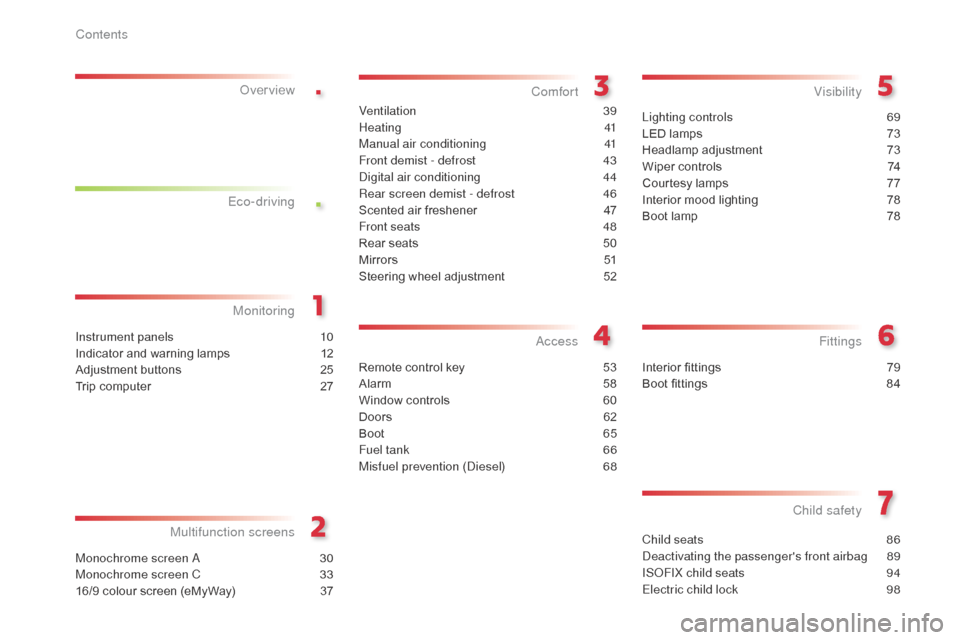
.
.
Child seats 86
dea
ctivating the passenger's front airbag
8
9
IS
oF
IX child seats
9
4
Electric child lock
9
8
Child safety
Instrument panels 10
Indicator and warning lamps
1
2
Adjustment buttons
2
5
Trip computer
2
7
MonitoringOver view
Monochrome screen a 3
0
Monochrome screen C
3
3
16/9 colour screen (eMyWay)
3
7
Multifunction screens
Ventilation 39
Heating
41
Manual air conditioning
4
1
Front demist - defrost
4
3
di
gital air conditioning
4
4
Rear screen demist - defrost
4
6
Scented air freshener
4
7
Front seats
4
8
Rear seats
5
0
M i r r o r s
51
S
teering wheel adjustment
5
2
Comfort
Remote control key 53
Alarm
5
8
Window controls
6
0
Doors
6
2
Boot
6
5
Fuel tank
6
6
Misfuel prevention (
die
sel)
6
8
access
Lighting controls 69
LED lamps
7
3
Headlamp adjustment
7
3
Wiper controls
7
4
Courtesy lamps
7
7
Interior mood lighting
7
8
Boot lamp
7
8
Visibility
Interior fittings 79
Boot fittings
8
4
Fittings
Eco-driving
Contents
Page 11 of 284

9
Limit the causes of excess consumption
Spread loads throughout the vehicle; place the heaviest items in the
bottom of the boot, as close as possible to the rear seats.
Limit the loads carried in the vehicle and reduce wind resistance (roof
bars, roof rack, bicycle carrier, trailer...). Use a roof box in preference.
Remove roof bars and roof racks after use.
At the end of winter, remove snow tyres and refit your summer tyres.
Observe the recommendations on maintenance
Check the tyre pressures regularly, when cold, referring to the label in
the door aperture, driver's side.
Carry out this check in particular:
-
b
efore a long journey,
-
a
t each change of season,
-
a
fter a long period out of use.
Don't forget the spare wheel and the tyres on any trailer or caravan.
Have your vehicle serviced regularly (engine oil, oil filter, air filter,
passenger compartment filter...) and observe the schedule of
operations recommended in the maintenance and warranty guide.
With a
b
l
ueH
di
d
i
esel engine, if the SCR system is faulty your vehicle
becomes polluting; go to a CITROËN dealer or a qualified workshop
without delay to have the emissions of nitrous oxides brought back to
the legal level.
When refuelling, do not continue after the third cut-off of the nozzle to
avoid any over flow.
At the wheel of your new vehicle, it is only after the first 1 800 miles
(3 000 kilometres) that you will see the fuel consumption settle down to
a consistent average.
Eco-driving
.
Page 50 of 284
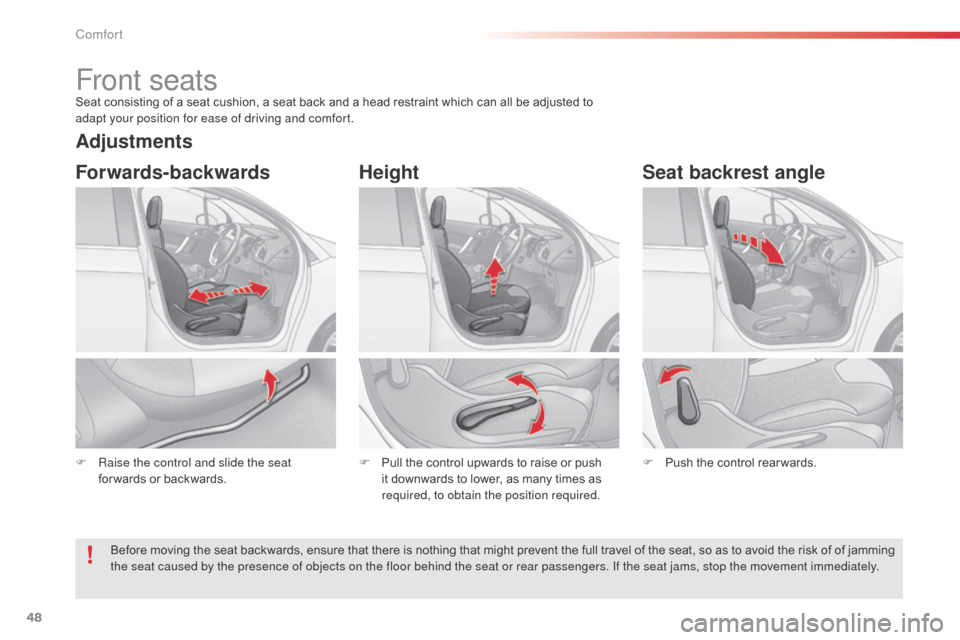
48
Front seatsSeat consisting of a seat cushion, a seat back and a head restraint which can all be adjusted to
adapt your position for ease of driving and comfort.
F
Ra
ise the control and slide the seat
for wards or backwards. F
P
ull the control upwards to raise or push
it downwards to lower, as many times as
required, to obtain the position required.
Forwards-backwards Height
F Push the control rear wards.
Seat backrest angle
Adjustments
Before moving the seat backwards, ensure that there is nothing that might prevent the full travel of the seat, so as to avoid the risk of of jamming
the seat caused by the presence of objects on the floor behind the seat or rear passengers. If the seat jams, stop the movement immediately.
Comfort
Page 52 of 284
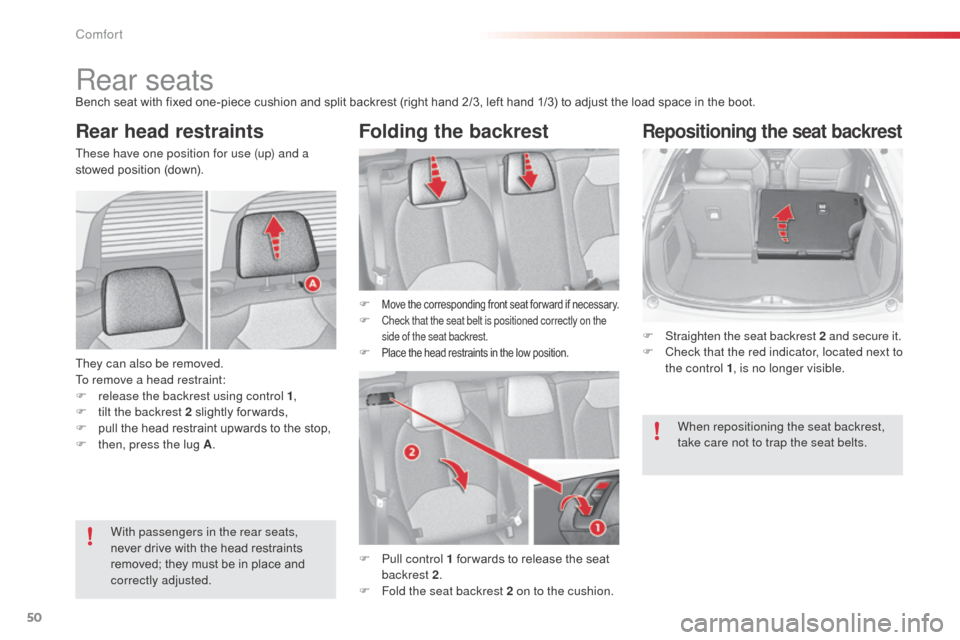
50
Rear seatsBench seat with fixed one-piece cushion and split backrest (right hand 2/3, left hand 1/3) to adjust the load space in the boot.
Rear head restraintsFolding the backrest
They can also be removed.
To remove a head restraint:
F
r
elease the backrest using control 1 ,
F
t
ilt the backrest 2 slightly for wards,
F
p
ull the head restraint upwards to the stop,
F
t
hen, press the lug A . F
Move the corresponding front seat for ward if necessary.F Check that the seat belt is positioned correctly on the
side of the seat backrest.
F Place the head restraints in the low position.
With passengers in the rear seats,
never drive with the head restraints
removed; they must be in place and
correctly adjusted.
These have one position for use (up) and a
stowed position (down).
F
P
ull control 1 for wards to release the seat
backrest 2 .
F
F
old the seat backrest 2 on to the cushion.
Repositioning the seat backrest
When repositioning the seat backrest,
take care not to trap the seat belts.
F
S
traighten the seat backrest 2
and secure it.
F
C
heck that the red indicator, located next to
the control 1 , is no longer visible.
Comfort
Page 88 of 284

86
General points relating to child seats
Although one of CITROËN main criteria when designing your vehicle, the safety of your children
also depends on you.CITROËN recommends that children
should travel on the rear seats of your
vehicle:
-
"
rearward-facing" up to the age of 3,
-
"
forward-facing" over the age of 3.
*
T
he regulations on carrying children are
specific to each country. Refer to the
legislation in force in your country.
For maximum safety, please observe the
following recommendations:
-
i
n accordance with European regulations,
all children under the age of 12 or less
than one and a half metres tall must
travel in approved child seats suited to
their weight , on seats fitted with a seat
belt or IS
oF
IX mountings*,
-
s
tatistically, the safest seats in your
vehicle for carr ying children are the
rear seats,
-
a c
hild weighing less than 9 kg must
travel in the "rear ward facing" position
both in the front and in the rear.
Child safety
Page 89 of 284
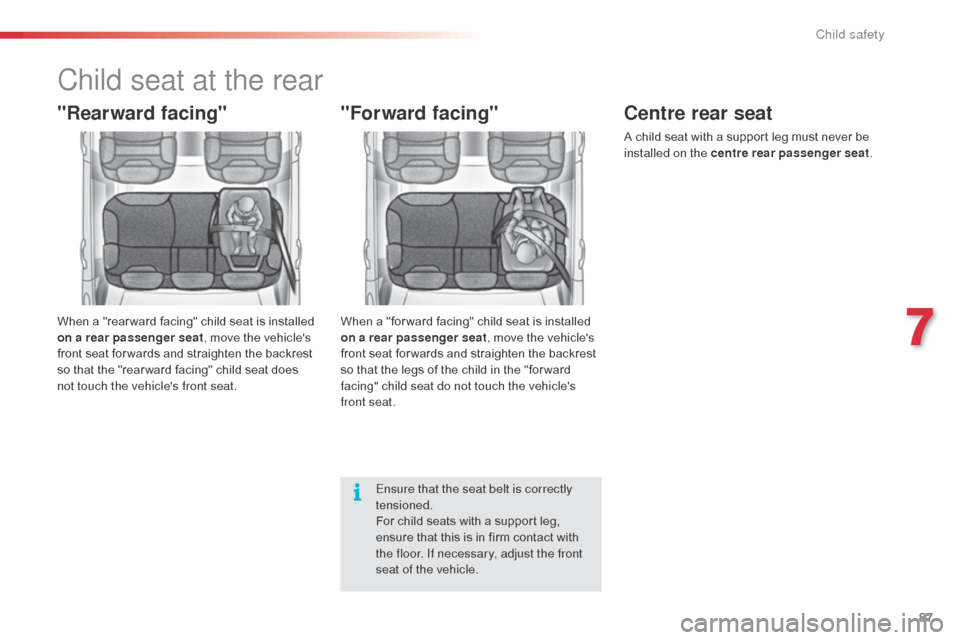
87
Child seat at the rear
"Rearward facing"
When a "rear ward facing" child seat is installed
on a rear passenger seat, move the vehicle's
front seat for wards and straighten the backrest
so that the "rear ward facing" child seat does
not touch the vehicle's front seat.
"Forward facing"
When a "for ward facing" child seat is installed
on a rear passenger seat , move the vehicle's
front seat for wards and straighten the backrest
so that the legs of the child in the "for ward
facing" child seat do not touch the vehicle's
front seat.
Ensure that the seat belt is correctly
tensioned.
For child seats with a support leg,
ensure that this is in firm contact with
the floor. If necessary, adjust the front
seat of the vehicle.
Centre rear seat
A child seat with a support leg must never be
installed on the centre rear passenger seat .
7
Child safety
Page 90 of 284

88
"Forward facing"
When a "for ward facing" child seat is installed
on the front passenger seat, adjust the
vehicle's seat to the intermediate longitudinal
position with seat backrest straightened and
leave the passenger's front airbag activated.
"Rearward facing"
When a "rear ward facing" child seat is installed
on the front passenger seat , adjust the seat to
the intermediate longitudinal position, with the
backrest straightened.
The passenger's front airbag must be
deactivated. Otherwise, the child would
risk being seriously injured or killed if the
airbag were to inflate . Passenger seat adjusted to the intermediate
longitudinal position.
Ensure that the seat belt is correctly
tensioned.
For child seats with a support leg,
ensure that the support leg is in stable
contact with the floor. If necessary,
adjust the passenger seat.
Child seat in the front*
* The rules on carrying children are specific to each country. Refer to the current legislation
in your country before installing a child seat
on this seat.
Child safety
Page 94 of 284
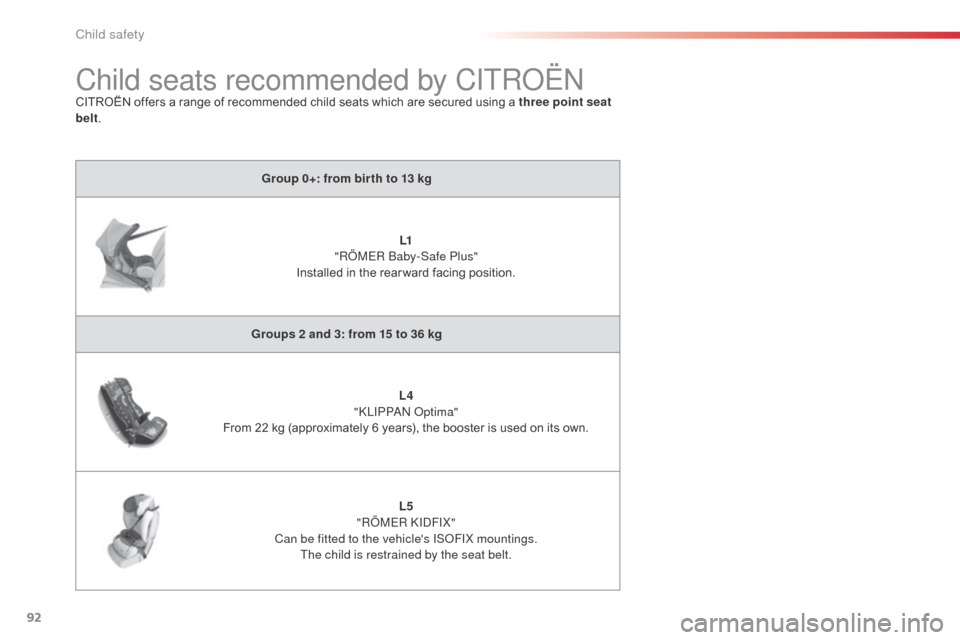
92
Child seats recommended by CITRoËnCITROËN offers a range of recommended child seats which are secured using a three point seat
belt.
Group 0+: from bir th to 13 kg
L1
"RÖMER
b
a
by-Safe Plus"
Installed in the rear ward facing position.
Groups 2 and 3: from 15 to 36 kg L4
"
kL
IPP
a
n o
p
tima"
From 22 kg (approximately 6 years), the booster is used on its own.
L5
"RÖMER
k I d FIX"
Can be fitted to the vehicle's IS
oF
IX mountings.
The child is restrained by the seat belt.
Child safety
Page 95 of 284

93
Weight of the child and indicative age
Seat Under 13 kg
(groups 0 (b) a n d 0 +)
Up to approx 1 year From 9 to 18 kg
(g r o u p 1)
1 to 3 years approx From 15 to 25 kg
(group 2)
3 to 6 years approx From 22 to 36 kg
(group 3)
6 to 10 years approx
Front passenger seat (c) UUUU
ou
ter rear seats UUUU
Centre rear seat UUUU
Installing child seats attached using the seat beltIn accordance with European regulations, this table indicates the options for installing child seats secured using a seat belt and universally approved (a)
in accordance with the weight of the child and the seat in the vehicle.
(a) Universal child seat: child seat that can be installed in all vehicles using a seat belt.
(b )
G
roup 0: from birth to 10 kg. Shells seats and baby carriers cannot be installed in the front
passenger seat. When installed in the 2
nd row, they may prevent use of the other seats.
(c ) Consult the legislation in force in your country before installing your child on this seat.
U :
S
eat suitable for the installation of a child seat secured using a seat belt and universally
approved, "rear ward facing" and/or "for ward facing". Remove and stow the head restraint
before installing a child seat with a
backrest on a passenger seat. Refit the
head restraint once the child seat has
been removed.
7
Child safety
Page 96 of 284
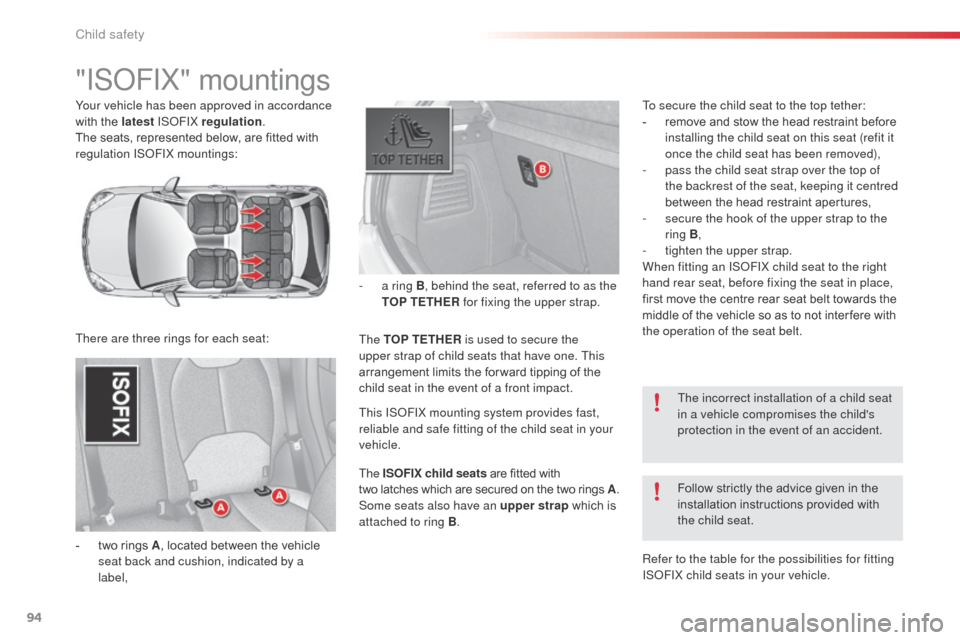
94
Your vehicle has been approved in accordance
with the latest ISoFIX regulation.
The seats, represented below, are fitted with
regulation IS
oF
IX mountings:
-
t
wo rings A , located between the vehicle
seat back and cushion, indicated by a
label, The TOP TETHER is used to secure the
upper strap of child seats that have one. This
arrangement limits the for ward tipping of the
child seat in the event of a front impact. -
a r
ing B, behind the seat, referred to as the
TOP TETHER for fixing the upper strap.
Follow strictly the advice given in the
installation instructions provided with
the child seat.
"ISoFIX" mountings
The incorrect installation of a child seat
in a vehicle compromises the child's
protection in the event of an accident.
There are three rings for each seat: To secure the child seat to the top tether:
-
r
emove and stow the head restraint before
installing the child seat on this seat (refit it
once the child seat has been removed),
-
p
ass the child seat strap over the top of
the backrest of the seat, keeping it centred
between the head restraint apertures,
-
s
ecure the hook of the upper strap to the
ring B ,
-
t
ighten the upper strap.
When fitting an IS
oF
IX child seat to the right
hand rear seat, before fixing the seat in place,
first move the centre rear seat belt towards the
middle of the vehicle so as to not inter fere with
the operation of the seat belt.
Refer to the table for the possibilities for fitting
IS
oF
IX child seats in your vehicle.
This ISoF
IX mounting system provides fast,
reliable and safe fitting of the child seat in your
vehicle.
The ISOFIX child seats are fitted with
two
l
atches which are secured on the two rings A.
Some seats also have an upper strap which is
attached to ring B .
Child safety